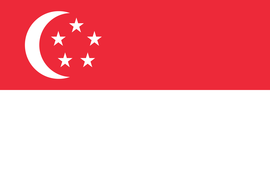
新加坡共和国(以下简称新加坡),面积724.4平方公里,人口570万(2019年6月)。华人占74%左右,其余为马来人、印度人和其他种族。马来语为国语,英语、华语、马来语、泰米尔语为官方语言,英语为行政用语。主要宗教为佛教、道教、伊斯兰教、基督教和印度教。
新加坡是热带城市国家,位于马来半岛南端、马六甲海峡出入口,北隔柔佛海峡与马来西亚相邻,南隔新加坡海峡与印度尼西亚相望。由新加坡岛及附近63个小岛组成,其中新加坡岛占全国面积的88.5%。地势低平,平均海拔15米,最高海拔163米,海岸线长193公里。属热带海洋性气候,常年高温潮湿多雨。年平均气温24℃~32℃,日平均气温26.8℃,年平均降水量2345毫米,年平均湿度84.3%。
新加坡属外贸驱动型经济,以电子、石油化工、金融、航运、服务业为主,高度依赖中、美、日、欧和周边市场,外贸总额是GDP的四倍。经济曾长期高速增长,1960~1984年间GDP年均增长9%。1997年受到亚洲金融危机冲击,但并不严重。2001年受全球经济放缓影响,经济出现2%的负增长。2010年经济增长14.5%。2011年,受欧债危机负面影响,经济增长再度放缓。2017年、2018年经济增长率分别达到3.5%、3.2%。2019年,受全球经济放缓影响,经济增长率仅为0.8%。人均GDP高于大多数发达国家,失业率低。
2019年,国内生产总值3768亿美元,人均国内生产总值6.6万美元,国内生产总值增长率0.8%。
The Republic of Singapore (hereinafter referred to as Singapore) covers an area of 724.4 square kilometers and has a population of 5.7 million (June 2019). Chinese account for about 74%, and the rest are Malays, Indians and other races. Malay is the national language, English, Chinese, Malay and Tamil are the official languages, and English is the administrative language. The main religions are Buddhism, Taoism, Islam, Christianity and Hinduism.
Singapore is a tropical city country. It is located at the southern end of the Malay Peninsula and the entrance and exit of the Malacca Strait. It is adjacent to Malaysia across the Johor Strait in the north and Indonesia across the Singapore Strait in the south. It is composed of Singapore Island and 63 nearby islands, of which Singapore Island accounts for 88.5% of the national area. The terrain is low and flat, with an average altitude of 15 meters, a maximum altitude of 163 meters and a coastline of 193 kilometers. It is a tropical marine climate with high temperature, humidity and rain all year round. The annual average temperature is 24 ℃ ~ 32 ℃, the daily average temperature is 26.8 ℃, the annual average precipitation is 2345 mm, and the annual average humidity is 84.3%.
Singapore is a foreign trade driven economy, dominated by electronics, petrochemical, finance, shipping and service industries. It is highly dependent on China, the United States, Japan, Europe and surrounding markets, and its total foreign trade is four times of GDP. The economy grew at a high speed for a long time, with an average annual GDP growth of 9% from 1960 to 1984. It was hit by the Asian financial crisis in 1997, but it was not serious. In 2001, affected by the global economic slowdown, the economy showed negative growth of 2%. In 2010, the economy grew by 14.5%. In 2011, economic growth slowed down again due to the negative impact of the European debt crisis. In 2017 and 2018, the economic growth rate reached 3.5% and 3.2% respectively. In 2019, affected by the global economic slowdown, the economic growth rate was only 0.8%. The per capita GDP is higher than that of most developed countries, and the unemployment rate is low.
In 2019, the GDP was 376.8 billion US dollars, the per capita GDP was 66000 US dollars, and the GDP growth rate was 0.8%.













